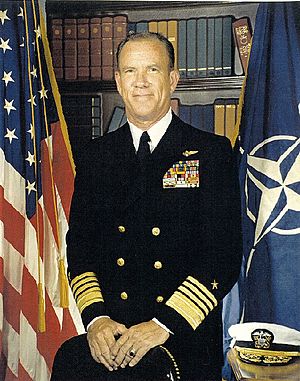George E. R. Kinnear II facts for kids
Quick facts for kids
George E. R. Kinnear II
|
|
|---|---|
 |
|
| Birth name | George Espy Ridgeway Kinnear II |
| Nickname(s) | Gus |
| Born | January 12, 1928 Mounds, Oklahoma, US |
| Died | August 9, 2015 (aged 87) York Harbor, Maine, US |
| Allegiance | United States of America |
| Service/ |
United States Navy |
| Years of service | 1945–1982 |
| Rank | |
| Commands held | VFA-106 (1963-64), CVW-2 (1966-1968), CVBG-1 (1974-1975), AIRLANT(1978-1980), U.S. Military Representative - NATO Military Committee (1981-1982). |
| Awards | Distinguished Service Medal w/ gold star (two awards), Legion of Merit w/ 3 gold stars and Combat "V" (four awards), Distinguished Flying Cross w/ 3 gold stars and Combat "V" (four awards), Air Medal w/ 3 silver stars and Combat "V" (sixteen awards), Navy Commendation Medal w/ 4 gold stars and Combat "V" (five awards). |
| Other work | Vice President - Grumman Aerospace (1982-1988), President & Executive Vice President - University of New Hampshire (1988-1992), Vice-Chairman and CEO - New England Digital Corporation (1992), Chairman, eVelocity Corporation (1986-2002), Chairman, KCA LLC (2011-2015). |
George Espy Ridgeway "Gus" Kinnear II (January 12, 1928 – August 9, 2015) was a highly respected four-star admiral in the United States Navy. He was known for his amazing flying skills and leadership. Admiral Kinnear also served as the U.S. Military Representative to the NATO Military Committee, which is a group of military leaders from different countries working together.
Contents
Gus Kinnear was born on January 12, 1928, in Mounds, Oklahoma. He grew up in Brooksville, Florida. When he was just 17 years old, he decided to join the U.S. Navy. This was in January 1945, during World War II. He even left high school early to serve his country. Later, he did get his high school diploma.
Gus Kinnear loved to fly. In June 1945, he was chosen for pilot training. By August 1948, he became a Naval Aviator, meaning he was a trained pilot for the Navy. He then became an Ensign, a junior officer, in December 1948.
Flying in Combat
Kinnear flew many missions during his long career.
- He flew combat missions in the Korean War in 1953.
- Later, he flew in the Vietnam War. He was a pilot and a leader in several squadrons.
- He commanded Attack Squadron 106 from 1963 to 1964.
Advanced Education and Leadership
Admiral Kinnear was not only a great pilot but also a dedicated student.
- He earned two degrees from George Washington University in 1957.
- He also graduated from the Naval War College in 1961.
- In 1966, he earned two more degrees, including a Ph.D., from Stanford University.
After his studies, he continued to take on important leadership roles.
- He commanded Air Wing Two from 1966 to 1968. This was the first "all-jet" combat airwing.
- He flew many types of jet aircraft, including the A-4, A-6, F-4, and A-7.
- He even flew the first combat strike with the A-7 aircraft against enemy positions in Hanoi.
- In 1968, he was involved in operations when the USS Pueblo was captured by North Korea.
In July 1971, Kinnear became the commander of NAS Miramar in San Diego. This base was famous for the Navy's "Top Gun" school. He helped expand the base and bring in the new F-14 fighter jets.
He was promoted to rear admiral and returned to sea in 1974-75. He commanded Carrier Group Two in the Tonkin Gulf. He helped set up a new digital system for carrier battle groups called "Outlaw Hawk."
Later, he became the Assistant Chief of Naval Personnel. In April 1978, he was promoted to vice admiral. He took command of the Naval Air Force Atlantic Fleet. Finally, in July 1981, he became a full Admiral. He then served as the U.S. Military Representative to the NATO Military Committee. He retired from the Navy in September 1982.
Admiral Kinnear was an incredible pilot. He flew more different types of jet aircraft in combat than any other naval aviator. He spent over 5,000 hours flying and made more than 950 landings on aircraft carriers!
Awards and Honors
Admiral Kinnear received many awards for his bravery and service:
- Air Medal: Awarded sixteen times for heroic actions while flying.
- Distinguished Flying Cross: Awarded four times for outstanding achievements in flight.
- Distinguished Service Medal: Awarded twice for exceptionally meritorious service.
- Legion of Merit: Awarded four times for exceptionally meritorious conduct.
- Navy Commendation Medal: Awarded five times for heroic or meritorious achievement.
After retiring from the Navy, Admiral Kinnear continued to be very active.
- He joined Grumman Aerospace Corporation as a corporate vice president in 1982.
- He also served as Chairman of the Board for The Retired Officers' Association (TROA).
- He was on the boards of several important companies and organizations, including Compaq Corporation. He helped Compaq make a big decision to use standard computer parts, which led to the "plug and play" technology we use today.
- From 1988 to 1992, he was the Executive Vice President and President of the University of New Hampshire.
- He also served as Vice Chairman and CEO of New England Digital Corporation.
- In 1999, he co-founded a technology company called eVelocity Corporation and served as its Chairman.
- He even published a biography in 2014.
Admiral Kinnear passed away in August 2015, at the age of 87. He left behind a legacy of service, leadership, and innovation.

